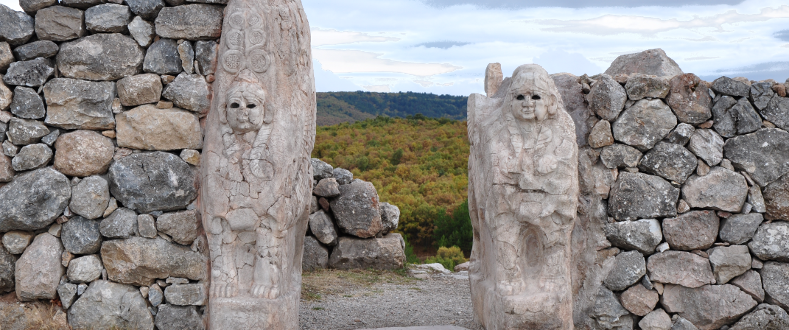A Sketch of Hittite History
Between ca. 1600-1200 BC, the great kings of the Hittites ruled the majority of what is today Turkey, and for a significant period of time the northern half of Syria and even Cyprus temporarily. The Egyptian pharaohs and the kings of Babylon considered them their equals of the same status, maintained regular diplomatic contact and established parity treaties with them. Large collections of cuneiform tablets written in seven different languages were deposited in the Hittite palaces and temples, and in the 13th century BC their capital city Hattuša (beside the present day rural town of Boğazkale, previously Boğazköy – “gorge-village”, 160 km east of Ankara) covering an area of 2 square km was one of the most extensive urban settlements of the world.
The memory of the great empires of the Egyptians, Babylonians and Assyrians was retained over the millennia right up until the modern era through the biblical and classical textual traditions. The Anatolian empire of the Hittites, on the contrary, was forgotten so completely that Herodotus, for example, attributed a Hittite relief in western Asia Minor to an Egyptian pharaoh, Sesostris. Nevertheless, some small states in southern Anatolia and in northern Syria continued the Hittite traditions for several centuries after the destruction of the Anatolian great empire at the beginning of the 12th century BC.
This final point is also the reason why the name of the Hittites did not disappear completely: The Bible speaks repeatedly of them. The biblical references to the Hittites reflects precisely the situation after the downfall of the Hittite Great Empire when the name of the land Hatti – originally a term for the region in north-central Anatolia with the capital city at Hattuša – was transferred onto the region of the Syrian states which were the heirs of the Hittite empire: For example, in the 8th century BC the Assyrian king Sargon II speaks of a “palace after the manner of the land of Hatti”, by which he meant Syria and not Anatolia.
Through the discovery and evaluation of thousands of cuneiform tablets discovered in the excavations in Hattuša – among them numerous annals as well as royal edicts and letters – it became possible to reconstruct the substantial events of Hittite history. Nevertheless, many aspects still remain unclear, for example the precise chronology of the kings, and new text finds frequently supplement or modify our understanding of history, as was especially the case with the sensational discoveries of the 1980s and early 1990s.
The Period of the Assyrian Trade Colonies in Anatolia
The early era of the Hittites still remains obscure. It is certain that the Hittite language belongs to the widespread family of Indo-European languages, from which it can be deduced that the Hittites immigrated to Anatolia. However, even the question of when this immigration took place and which route it might have taken has yet to find a reliable answer. It is also certain that the Hittites already lived in Anatolia in the period when merchants from distant Assyria established trading colonies in various Anatolian cities and introduced Mesopotamian cuneiform writing to Anatolia.
The contents of a Hittite text, copies of which were preserved in the clay tablet collections of Hattuša, echo the era of the Assyrian trading colonies. Therein, a king named Anitta tells of the deeds of his father Pithana and of his own military campaigns by which he conquered an empire consisting of vast portions of central Anatolia. Pithana stemmed from the yet undiscovered city of Kuššar from which the later Hittite dynasty also hailed. After he managed to bring Kaniš (Turkish Kültepe “ash hill”, near modern-day Kayseri), one of the most significant Anatolian cities, under his control by means of a night ambush, he relocated his residence there. Kaniš had long been the central location for the Assyrian merchants who lived there in a trading settlement (Assyrian kārum) at the foot of the city. They occasionally refer to the “great prince” Anitta in their letters, from which this ruler can be roughly connected with Mesopotamian history and dated around 1730 BC. Anitta also conquered and destroyed the city of Hattuša which up to that time had been the centre of an independent principality, after which he pronounced a curse upon its ruins.
Anatolia Between the Kültepe-Period and the Period of the “Old Kingdom” of the Hittites
Little is known about the era after Anitta. No contemporary sources are available from the following century since at the same time Assyrian trading in Anatolia also came to an end. Only the reminiscences of later Hittite texts provide us with some indications of the historical events of this period. According to these, the political landscape of Anatolia in the 17th century BC was also characterized by a series of city states. Again, it was a dynasty from Kuššar which by means of lengthy battles was able to conquer large portions of Anatolia.
The earliest known ruler to whom the kings of the Hittites trace themselves was name Huzziya. At the time of the Assyrian trading colonies, the same name was also borne by a king of the city of Zalpa on the Black Sea.
Zalpa played an exceptional role in the oldest Hittite traditions: An Old Hittite clay tablet, discovered in 1970 in Hattuša, preserves a legend according to which a queen of Kaniš bore 30 sons in a single year and set them out in baskets into the river. The river – undoubtedly the longest river in Anatolia known today as Kızıl Irmak – carried them to the land of Zalpuwa, that is, to the region of the city of Zalpa where they grew up. Later, they moved to Kaniš and married their 30 sisters whom the queen had also borne, thus the legend.
The interpretation of this narrative is difficult. Does it represent an immigration saga, as some have postulated? Is the incest intended to explain why a conflict arose between the great king and the city of Zalpa? Does the text indicate the origin of kingship from Zalpa? An archaic ritual refers to the fact that the throne goddess brought the rank of kingship “from the sea” – interesting since Zalpa lies on the sea, as is made clear by the legend about the children of the queen of Kaniš. Perhaps the Hittite dynasty originally stemmed from Zalpa, before they chose Kuššar as their residence.
Labarna I and Hattušili I
One of Huzziyas successors is Labarna I, to whom tradition attributes the conquest of several cities in the “lower land”, that is, in the region of the great Salt Sea (Turkish Tuz Gölü). However, royal self-references are only available from Labarna II, who also bore the name Hattušili I, although these for the most part are only known from younger copies. The name Hattušili shows that the curse which Anitta had once pronounced against anyone who would dare to resettle the site which he had destroyed was not respected for very long. The geographical situation of the city was simply too advantageous as to turn it over permanently to the “bulls of the Storm-god as pasture”, as Anitta had decreed it. The site was certainly resettled quite soon and later became the residential city of the kings, at the latest under Hattušili.
The Syrian city-states became the primary target of Hittite expansion. These lay at the intersection of important trade routes and had attained enormous wealth through trade, craftsmanship and agriculture. Furthermore – stimulated by close connections with Mesopotamia – they had also developed a highly advanced culture.
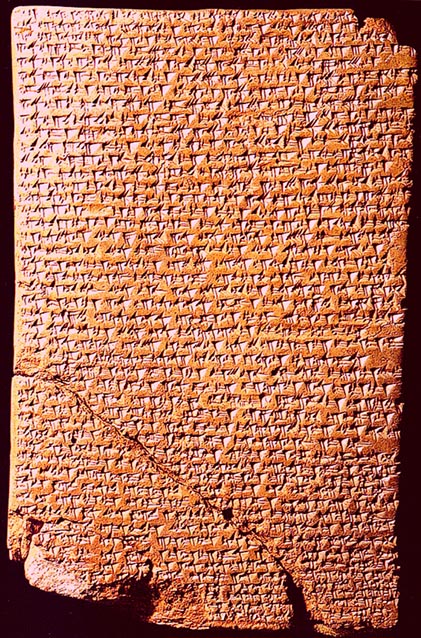
The primary enemy in Syria was Halab, modern-day Aleppo, which for one and a half centuries, had once been the most powerful player in the Near East alongside the empire of Hammurapi of Babylon, a position which had long since been lost. Nevertheless, the conquest of northern Syria was no mere trifle for Hattušili, since Aleppo was backed by a considerable force which had emerged in the 17th or early 16th century BC in northern Mesopotamia: Mittani. The population of this empire consisted mostly of Hurrians, a people attested since the 3rd millennium in eastern Upper Mesopotamia whose language had spread in the early 2nd millennium far to the west all the way to the Mediterranean. The dynasty of Mittani, however, made use of foreign names and religious traditions which identify them as a close relative of the same Indo-Arian population attested later in northern India.
Muršili I.
The first breakthrough in the southern expansion was achieved by Muršili I. Hattušili appointed him as successor to the throne after numerous conflicts with his own children (his daughter apparently led a revolt against him) and with his sister’s son, whom Hattušili had initially designated as his successor.
Muršili succeeded not only in conquering Aleppo, but he also proceeded over one thousand kilometres further downstream along the Euphrates in an astonishing campaign and took the city of Babylon, whose kings, however, had recently lost their position of power attained long before by Hammurapi. Nevertheless, this military achievement was of no lasting importance for the Hittite empire since the troops already encountered substantial difficulties on their return march.
Contentions for the Throne and Regicides
Muršili was later assassinated by his brother-in-law, Hantili, which began a long phase of bloody conflicts within the royal house. Claims to the throne were especially raised by the husband of the reigning king’s sister, from which some have inferred a rivalry between matrilineal and patrilineal traditions of succession to the throne. The sources, however, do not allow for any certain conclusions on this matter.
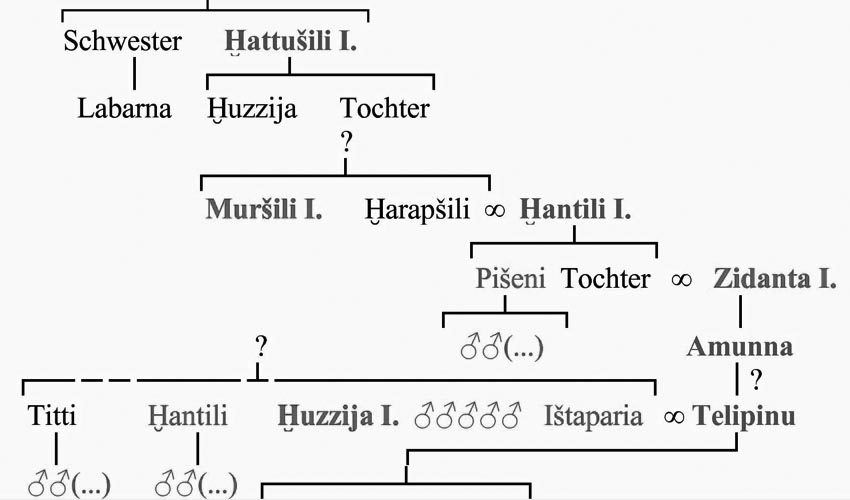
In the second half of the 15th century, king Telipinu undertook aggressive efforts to improve the economic as well as domestic and foreign political circumstances. He established storehouses at various locations in the kingdom and issued numerous land donation deeds. By means of an edict regulating the succession to the throne, he attempted to preclude power struggles between members of the royal family. He established a treaty with the king of Kizzuwatna for the purpose of an organized and peaceful relationship.
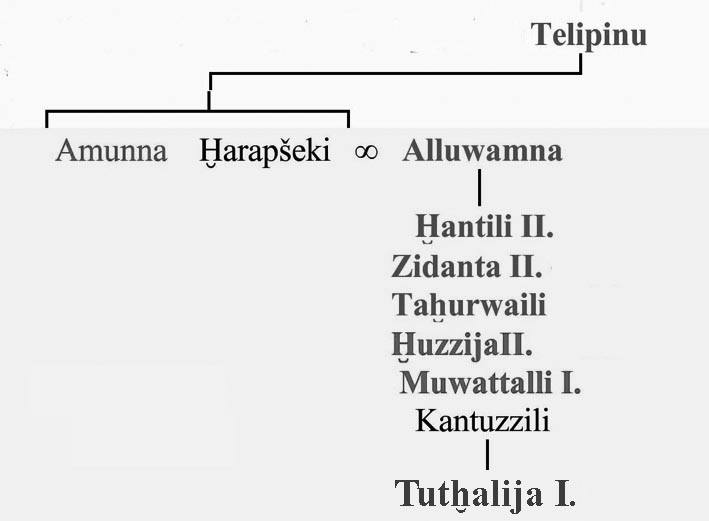
Tuthaliya I, Arnuwanda I and Tuthaliya II
The weak phase of the Hittite kingdom continued for half a century, until – after two further assassinations – Tuthaliya I ascended the throne and succeeded, at least temporarily, in re-establishing the position of power which had been lost. He persuaded the king of Kizzuwatna to defect from Mittani by making generous promises, but went on to annex this kingdom to his own.
Kizzuwatna had long been exposed to Hurrian influence, and Hurrian cults and rites had gained a foothold there. After the annexation of Kizzuwatna to the Hittite empire, these cults and rites were adopted by the Hittite upper class. It is possible that dynastic matrimonial connections were also at play here, in any case from this time on the members of the Hittite royal family often bore Hurrian names. Numerous Hurrian conjuration rituals, prayers, omens, myths and epics were copied for the temple and palace libraries in the capital city of Hattuša and in other places such as Šapinuwa (modern-day Ortaköy, near Çorum).
Tuthaliya I even succeeded in reconquering Aleppo and, together with his son, Arnuwanda, he led a campaign against the land of Aššuwa in western Anatolia.

All these military achievements, however, were short-lived because the Hittite empire soon afterwards was faced with a dangerous threat to its core region. At the time, the Kaškaeans lived in the region of the Pontic range north of the Hittite capital of Hattuša. Although their livelihood consisted of farming and animal husbandry, they improved upon their subsistent form of life by plundering Hittite villages and cities.
During the time of Arnuwanda I and again under his son and successor, Tuthaliya II, the attacks of the Kaškaeans in the Hittite region took on catastrophic dimensions. Numerous settlements were destroyed, their sanctuaries plundered, and their populations dislodged, killed or carried off. Finally, the capital city itself came under threat and was possibly even set on fire. Later in the reign of Tuthaliya, the empire was to a certain degree reconsolidated and apparently attempts were made to regain control over Kizzuwatna and the connected city of Alalah in the south.
Initially, it appears that Tuthaliya II preferred Šapinuwa (Ortaköy) as his residence, while during his later reign he remained more often in the city of Šamuha on the upper Kızıl İrmak (probably Kayalıpınar west of Sivas) and due to his poor health left the command of the troops to his generals.
Šuppiluliuma I
One of the princes distinguished himself especially and fought against the Kaškaeans with considerable success – Šuppiluliuma. Once the immediate threat to the core of the Hittite territory had been set aside, Šuppiluliuma successfully proceeded to reconquer southwest Anatolia, where the kingdom of Arzawa had become so well established that it even maintained diplomatic relationships with the Egyptian pharaoh.
After the death of his father, Šuppiluliuma’s prestige as a successful commander of the troops enabled him to claim the throne for himself, which rightfully belonged to his brother or half-brother Tuthaliya (III). He, in turn, was murdered – the first regicide since four generations, but it would also remain the last right up until the downfall of the Hittite empire.
In order to some extent to justify his usurpation of the throne, Šuppiluliuma undertook a military campaign of decisive importance for the remainder of Hittite history and with which the so-called “Great Empire period” began. In order to properly evaluate this event, one must be aware of the broader political landscape of the time.
The main powers of Western Asia at the beginning of Šuppiluliuma’s reign were Egypt, Mittani and Babylonia. Egypt had long controlled Palestine and the southern half of Syria and, after extended military conflicts, achieved a peaceful equilibrium with Mittani, which dominated Upper Mesopotamia and Assyria.
The state archives of the pharaoh, discovered in Amarna in Middle Egypt, describe the intensive diplomatic communication which occurred among the rulers of these three lands. Both Egypt and Mittani had long ceased to be the strong expansive military powers which they had been a century earlier. The central power in Mittani was significantly weakened by a regicide and a usurpation, but probably also by undesirable societal and economic developments. On its east flank, Assyria had just established its own renewed independence, while Šuppiluliuma prepared to deliver the final blow and tried to strike the centre of the Mittani empire. His attempt to take the capital city of Waššukkanni failed primarily because of logistical difficulties. For this reason he moved on to the western regions of the Mittani empire and conquered all Mittanian vassal states west of the Euphrates. In the process, he came into conflict with Egypt when he conquered a vassal of the pharaoh who had approached him in hostility. Egypt – in a time of religious reforms during the reign of Echnaton – was in no position to put up significant resistance.
An unusual event falls into this period: The pharaoh had died (for decades there have been divergent opinions as to his identity) and as a last resort the Egyptian court decided to join themselves with their mighty opponent. The pharaoh’s widow requested Šuppiluliuma to send one of his sons to become her husband, and thus the king of Egypt – an astounding manoeuvre given the situation. Šuppiluliuma hesitated long with his decision – too long – because when he finally chose to accept the offer, the power structures in Egypt appear to have changed, and the Hittite prince sent to Egypt was killed.
The final years of Šuppiluliuma’s reign were filled with military campaigns against Egypt and especially the Assyrians, who in the meantime had captured the eastern regions of Mittani. Šuppiluliuma succeeded in establishing Šattiwazza, a member of the old Mittanian dynasty who had sought refuge with him after the collapse of Mittani, as king in Waššukkanni.
Muršili II
After the death of Šuppiluliuma around 1320 BC, it once again became quite obvious that power and stability depended to a very large degree upon the charisma of the ruler; the institution of the “state” as such was quite rudimentary and poorly consolidated. Following their return from the Egyptian campaigns, the Hittite troops had brought back with them a deadly plague which raged for years and to which Šuppiluliuma’s successor, Arnuwanda II, most likely fell victim.
Subsequently, a young prince took the throne who had had no opportunity to prove his military prowess. Although this king bore the ambitious name Muršili, he nevertheless spent most of his reign preserving and securing the empire which he inherited and was unable to devote himself to lofty plans such as those of his namesake and predecessor who conquered Babylon. Altogether though, the reign of Muršili II was a successful one. He managed to regain control over Arzawa in western Anatolia and obligated several of the rulers there to loyalty to himself through vassal treaties. He profited from the circumstances in Syria where the last pharaohs of the 18th Dynasty (Tutankhamun and Eye) were initially in no position to take advantage of the Hittites’ difficult situation, even though the general and later king, Haremhab, intervened in Syria.
It was a great help to Muršili that his older half-brother, whom Šuppiluliuma had appointed king of the most important northern Syrian city of Kargamiš (on the Euphrates on the modern-day Turkish-Syrian border), who loyally represented the interests of the great king and suppressed revolts in Syria.
Muwattalli II
The latent conflict with Egypt broke out when the 19th Dynasty consolidated itself and Ramses II took the throne, a pharaoh who no longer accepted the power structures which Šuppiluliuma had established in Syria. A new king ascended the throne in Hatti as well. What was perhaps the largest battle of the 2nd millennium took place in 1274 between the troops of Ramses II and Muwattalli II near Qadesh in middle Syria. The Egyptians just barely escaped a serious defeat, but the Hittites were unable to realize their supremacy in the form of a genuine victory. The territorial status quo was preserved.
The most astonishing event of the reign of Muwattalli is the relocation of the capital city. Tarhuntaša became the great king’s new residence, a city which has not yet been located but in any case must be sought south of Hattuša and north of the Taurus range.
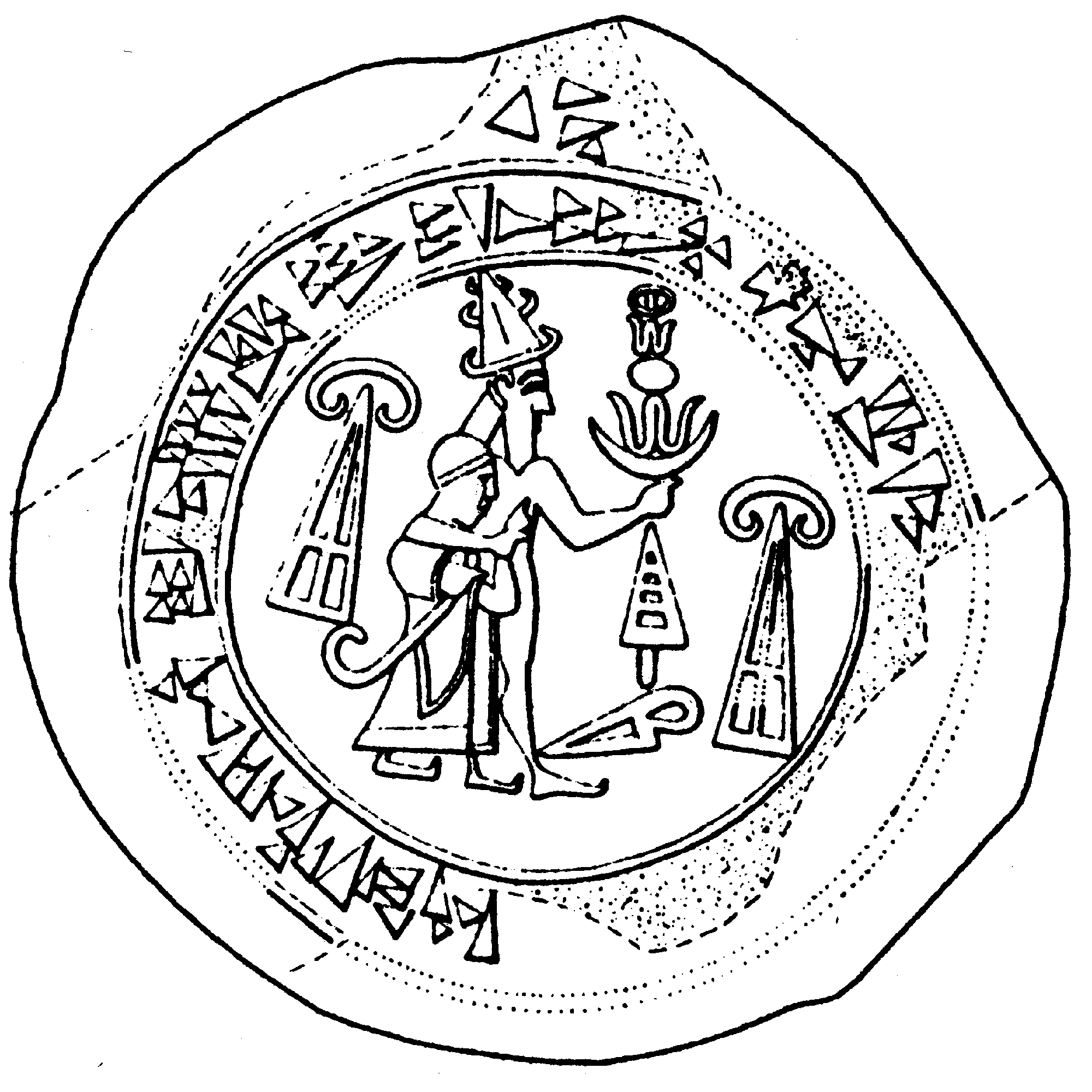
Muwattalli entrusted the administration of the north to his younger brother Hattušili. He was apparently very successful in recovering and resettling the regions which the Kaškaeans had ravaged. Upon Muwattalli’s death, his son Urhiteššub could hardly have stood against his aspiring and scheming uncle, who ultimately deposed him and ascended the throne himself.
Hattušili III
Hattušili III left us an unusual document, today referred to as his “Apology” and in which he justifies his usurpation of the throne with the claim that his personal protective deity had guided him and that the conduct of his nephew had left him with no other alternative.
Hattušili can be credited first and foremost with the establishment of long-term relationships with Egypt by means of a peace and goodwill treaty. Decades later, the pharaoh would respond to the famine-plagued land’s cry for help by sending a ship with grain to Anatolia.
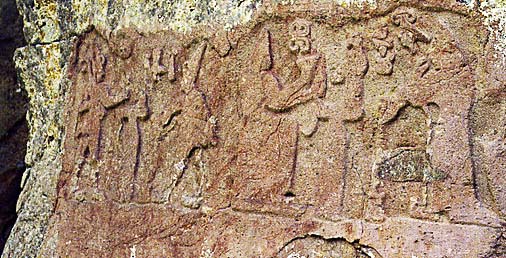
Tuthalija IV
Hattušili’s son and successor Tuthaliya IV was confronted with advancing Assyrians at the beginning of his reign. There may also have been a revolt led by a son of Muwattalli, Kurunta. He had been appointed king in Tarhuntaša after Hattušili moved the great king’s residence from there back to Hattuša.
Kurunta and Tuthaliya had been friends in their youth according to a treaty between them written on a bronze tablet discovered in Hattuša in 1986. This, however, apparently did not prevent Kurunta from claiming the office of the great king for himself, a claim which he considered to have been duly justified. Even if Tuthaliya IV, against the earlier opinion, was not the founder of the extensive upper city of Hattuša, he was able to implement an expansive building programme, as is clear from the inscriptions written in the hieroglyphic script which was increasingly used from this period on.
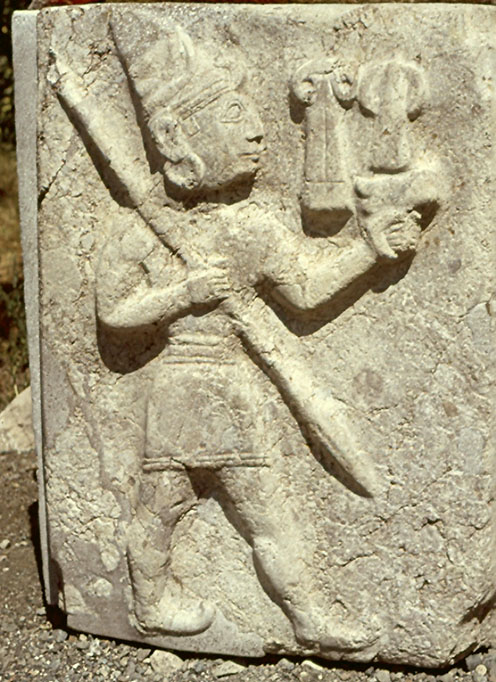
Šuppiluliuma II
One generation later the Hittite empire came to an end. The final king bore the name of the founder of the Hittite Great Empire. In some respects, Šuppiluliuma II does indeed appear to have been successful, but in the meantime developments had occurred which would lead to the collapse of the Bronze Age world in Western Asia.
Marauders from the Aegean – the so-called “sea peoples” – invaded the coasts of Anatolia and the Levant with the force of a Viking assault, famine led to mass migrations and large portions of Western Asia turned to steppes and became pastureland for nomadic tribes. The traditional empires of Assyria and Babylonia were reduced to their core regions, while the Hittite empire vanished altogether from the map. The Greek-Aegean realm was also affected, as the destruction of the Mycenaean fortresses demonstrates. Some indications suggest that these catastrophes were ultimately the result of large-scale climatic changes, but further research on this matter is necessary.
Due to the absence of sources, today we still do not know who or what caused the demise of the Hittite capital city and the end of the dynasty. Was it the rural population plagued by hunger? Was it the Kaškaeans who for a century had threatened the security of the capital city? Was it perhaps the newly immigrated populations such as the Phrygians who later settled in this region? What role did the internal problems such as the social antagonisms and attempts at independence on the part of the vassals play?
The capital city of Hattuša was apparently abandoned and then fell to ruin until the large buildings – in the meantime serving no function – went up in flames. Hittite traditions persisted for a long time in the region of Tarhuntaša and especially in southeastern Anatolia as well as in northern and middle Syria. The kings of Kargamiš stemmed from the line of the dynasty of great kings and themselves assumed the title of great king after the destruction of Hattuša. A branch line of this dynasty established a kingdom in Arslantepe near Malatya on the upper Euphrates. Even the rulers who reigned for some centuries in Hama in middle Syria also understood themselves in the line of the Hittite tradition.
When, however, the re-established empire of Assyria began expanding its sphere of power to the west in the 9th century BC, the small states of the Hittite world had very little with which to counter their advances. Little by little, they were obliged to pay tribute to the Assyrian kings and finally they merged completely into the Neo-Assyrian empire.
The text is based on the article “Das anatolische Reich der Hethiter“ (G. Wilhelm) in: DAMALS 29. Jg., 2/1997, 13-18.
© Gernot Wilhelm 2013
